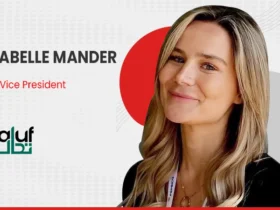Could you tell us about your journey in technology?
I started out in business early, and have always had an entrepreneurial mindset, being self-employed and starting new businesses since I was 17. This path led me to set up several IT and internet-based companies. I founded a company called My Phone Club in 2009, which offered a customer-centric solution for the mobile phone industry. Users had complete flexibility to change handset or network provider with just a month’s notice, along with a range of discounts and benefits nationwide, all in exchange for a fixed-cost monthly subscription. I’m now CEO of SmartFrame Technologies, which is first to market with a patented image-streaming technology. Our vision is to redefine the way in which images are viewed and published online, and to become the new online image standard.
What challenges did the COVID-19 pandemic pose for your team?
We expanded quite quickly during the course of the pandemic, so not being able to travel and meet new starters was one challenge. With four offices across two time zones, it’s always been important to meet regularly and have as much face-to-face contact as possible. As with many companies, we switched to webinars and digital-only presentations during this time, and this worked well for us, but it’s brilliant to be out at events and conferences again as digital-only events don’t allow for the same opportunities. Through all the challenges we’ve learned a lot about just how agile we can be and have really sought to make the best out of the situation. And today we’re a stronger company than we ever have been.
What sets SmartFrame apart from the competition?
From the perspective of image streaming, we’ve always been unique. We do not know of anyone else that offers a platform that delivers images in this way, and our patents would make it very difficult for someone else to copy us. As far as the protection over images is concerned, most approaches concern recovering losses as a result of theft, rather than actually preventing it to begin with, so that immediately makes us different.
But it’s the uniqueness of the proposition as a whole that makes the real difference. It’s the fact that we combine the above with relevant, privacy-compliant, cookie-free contextual targeting for brands – and a share of revenues from this advertising for content owners and publishers – together with detailed analytics and superior image presentation and engagement that makes SmartFrame as compelling a proposition as it is.
How do you envisage image management evolving in the years to come?
Not everyone has the same needs when it comes to managing their images, so it follows that no single solution will be right for everyone. We know that many of our users value being able to store images in the cloud as it’s ideal from the perspective of access, and many casual users now do so without even thinking about it. So tools that better support cloud storage will need to evolve. On the whole, image management is likely to shift more towards browser-based options, apps and cloud-based tools for most people, and we expect that things like cataloging will be even easier to handle here. When it comes to raw files from cameras, archiving and so on, this is arguably more practical to do offline for several reasons. So I imagine most people with either more than a passing interest in photography, or with a sizable collection of images to manage for any other reason, will continue to adopt some kind of hybrid approach that best suits their specific requirements.
What three things can business owners can do to optimize their digital outreach?
There are many facets for digital outreach and arguably three core elements that are key to optimizing them. The first is deploying all elements of outreach (SEO, PR, paid media, etc) in a cohesive and unified manner as this helps to maximize both impact and performance. The second is to ensure there are stretching but realistic OKRs and KPIs in place, ones that are linked to business objectives, enabling the benchmarking of progress towards goals. The final one is to ensure there are robust reporting and feedback mechanisms to optimize all elements.
Also Read: IT Digest Interview with Jason Widup, VP of Marketing at Metadata.io
As a business leader, what metrics do you use to define success?
As a business, our goal is obviously to be increasing revenues and profits, year on year. Key to this growth is increasing the number of SmartFrames online and the number of publishers hosting them on their sites.
Certain other things that cannot be easily quantified are important too, such as noticing the greater awareness of SmartFrame in conversations with the industry and attracting an increasing number of renowned clients to our platform. It’s also vital that we have a happy team who are all clear on our mission and purpose. Again, this is harder to measure, but we can only do our best work when we ensure those boxes are ticked.
How do you see marketing automation impacting the traditional sales and marketing funnels?
Given the rapid digitization of people’s lives it is not surprising that around 67% of a typical B2B buyer’s journey is done online. Prospects have myriad methods of getting the lowdown on a company such as online review sites, industry news and blogs, vlogs, webinars, vox pops, social media, websites, long-form content and landing pages to name a few; today’s prospect is very digital savvy.
Digital content has a significant effect on the buying decision and the sheer numbers of potential touchpoints within an organization, combined with an increasingly single massive global market, make it impossible for a salesperson alone to manage the funnel. Importantly there is now a symbiotic relationship between sales and marketing and an alignment between the two in terms of the overarching narrative that is important for success.
Marketing automation can provide valuable sales and marketing intelligence regarding a prospect’s online behavior, adapting content to suit. Being able to carefully craft communications via automation that supports the sales cycle is now vital to create synergy. Saying the right thing at the right point in time to move the prospect down the funnel creates a competitive advantage, which ultimately drives revenues.
Could you name one person from the MarTech sector that you would like to see featured here?
I’d say Reid Hoffman would be a great person to feature. He’s had a varied career, starting out at Paypal before co-founding Linkedin, and now being invested in AI and AI ethics among other things. He is, quite clearly, a very smart man who has not sought to pigeonhole himself in any one area, but to stretch his interests and passions far and wide. And he has been phenomenally successful as a result.
Could you name the Top 5 apps/platforms that you use for marketing?
We have long used Salesforce, and have recently augmented this with Pardot to help with marketing automation. The team has expanded recently and, as a company, we felt that we had outgrown the system we were previously using.
Over the last few months, we have also been advertising on Linkedin and in paid search, which has been very successful in terms of visibility and brand awareness. SEMRush has also been a useful tool for planning content, understanding audiences, and even for social media posting.
What advice would you give to someone who aspires to be a business leader?
On a personal level, you have to think positively and be passionate about the company you’re leading or the product you’re selling. If you’re not passionate, why should anyone else be? People need to be able to trust you and believe in you, and that’s infinitely easier to achieve if people can see you’re being genuine. Know your product, know your industry, and have a clear idea of what it is you’re trying to achieve, and it’ll be easier for the rest to fall into place.




































